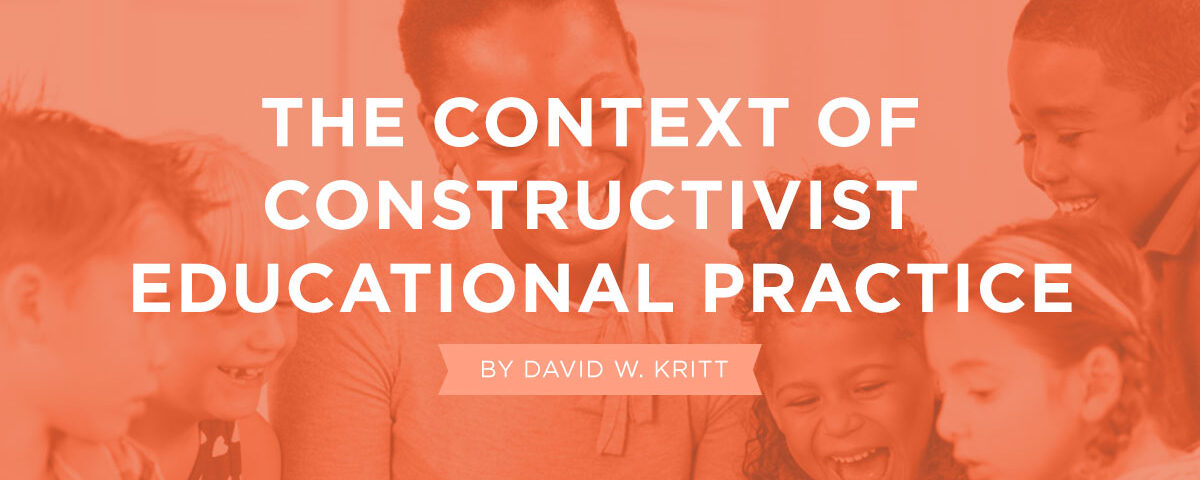The Context of Constructivist Educational Practice
by David W. Kritt
This brief outline of educational policy, current school environments, and their implications for constructivist education in public schools is an initial formulation and, as such, invites readers to extend the discussion.
Policy
Although public education is the responsibility of states and localities, federal funding has affected schools nationwide. The watershed Civil Rights Act of 1964 was followed in 1965 with the Elementary and Secondary Education Act and the establishment of Title 1 funding, which remains the largest federal school program. National attention was again redirected in 1983, when the report, A Nation at Risk, compared U.S. student achievement unfavorably to other countries and focused concerns on economic competitiveness. Since the mid-1990s, Federal funding guidelines initiated by both Republican and Democratic administrations, such as No Child Left Behind and Race to the Top, have fueled testing as a measure of accountability and the embrace of standards as the path to saving American education. Common Core Standards curriculum guidelines, originating from non-governmental sources but adopted by the vast majority of state boards of education, seem premised on the notion that providing all students the same input will yield the same understandings and achievements. Despite insufficient evidence to back up this claim, they remain the major influences on education in the U.S.
COVID-19 and online education
The educational terrain changed in another way in the spring of 2020 when the coronavirus pandemic necessitated online classes. Kindergarten and college teachers scrambled to learn new online platforms and polish, adapt, or revamp classes to fit them. There was a tendency to look to their capabilities and limitations and devise lessons according to those parameters. The virtues of synchronous and asynchronous modes, or a combination of the two, dominated discussions with colleagues.
Some devoted time and energy to the production of polished presentations, sometimes edited videos that can be accessed at any time, with smooth delivery, pacing, lighting, and visual and auditory enhancements. These features were readily recognizable as marks of quality by both students and supervisors. Many more educators relied on live sessions on Zoom and other platforms. In the early days there were many technical difficulties on both the sending and receiving ends, and an unnatural distanced quality was evident. Nonetheless it would be wrong to idealize face-to-face education, where physical proximity does not guarantee fluid repartee, rapt attention, or engagement.
Previous critiques of technology and education (e.g., Kritt & Winegar, 2007) have not been refuted because of widespread use. Nor did the title of Cuban’s 2003 book about computers in the classroom, “oversold and underused”, become any less apt. The necessity of reliance on online instruction during perilous times does not mean that those methods should be embraced. But proponents of technological skills have amplified the centrality of the new modes of teaching-learning for the future, especially citing their instrumentality for employment. While there may be some truth to these prognostics, this is not an inevitable trajectory, only a highly promoted one, part of an opportunistic agenda to permanently increase both the use of technology and, often, privatization of education.
One city’s response
And so we must ask, can constructivism survive COVID? A privately funded television ad recently appeared in New York State asserting that the way forward is increasing the cap on the number of charter schools permitted. The Chancellor of New York City public schools sent a “Letter to Families” on July 8, 2021 that contained highlights of an “Academic Recovery Plan” designed to help children “learn, heal, and thrive” with expanded mental health services, enhanced teacher training to support literacy, extended instructional time and enrichment activities, increased training of K-12 teachers to teach “computational thinking, problem-solving, and digital skills”, and curriculum that better reflects cultural and linguistic diversity. These responses to a difficult year-and-a-half were designed with faith that the threat of COVID was over and there would be a full return to in-person classrooms. This was before the spread of variants of the virus and the experiences of schools in other parts of the country (e.g., Florida, Texas, Idaho, Oregon) that opened earlier but had to close and go back to online mode. So, it remains to be seen what will actually occur. These plans focus on making up for lost time and moving students through a curriculum in an efficient manner. What is clear is that there is nothing that is particularly constructivist in the plans, no concern with curiosity, exploration, or deep understanding.
Moving forward
Non-educators are confident that classroom teachers, administrators, and teacher educators will acquiesce to plans that promise to eclipse constructivist approaches to how we teach the young. The upcoming conference provides a space and community to renew and expand the vital work of constructivist education.
About ACT:
The Association of Constructivist Teachers (ACT) aims to grow the use of constructivist practice for all students and educators, pre-kindergarten through university.

